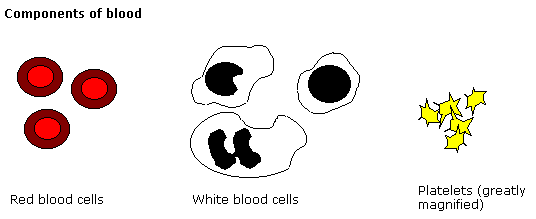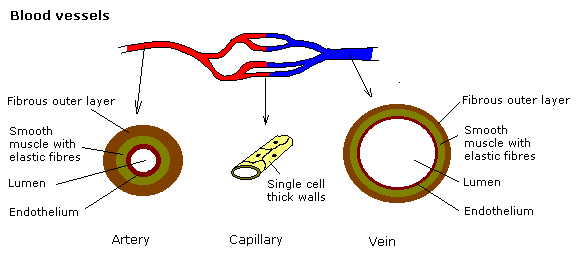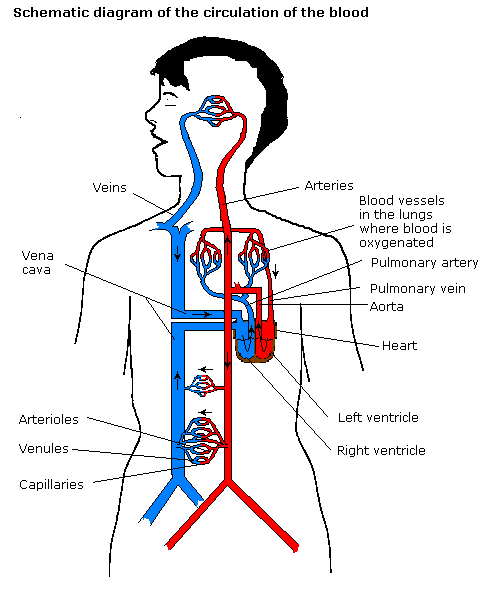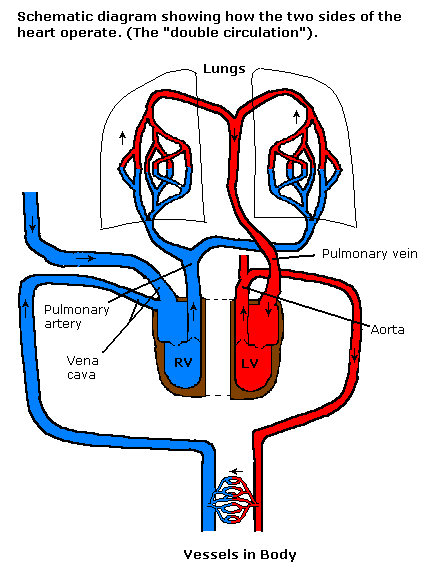GCSE Science/The Heart
< GCSE ScienceBlood
The blood transports food, proteins, blood cells, gases, water, minerals and waste products around the body.
Blood contains:
- Plasma - a straw coloured liquid in which the blood cells are suspended and the other components of the blood are dissolved.
- Red blood cells - these are red and doughnut shaped for a large surface area. They carry oxygen from the lungs to the tissues as oxy-haemoglobin (the oxygenated form of haemoglobin). They do not have a cell nucleus.
- White blood cells - these are colourless cells with a large cell nucleus. They defend the body against disease by engulfing micro-organisms (bacteria and viruses) and producing antitoxins and antibodies.
- Platelets - these are fragments of cells and very small. They do not have a cell nucleus. They form blood clots at the site of injuries. Clots protect the body from further infection and blood loss.

Blood vessels
Blood flows from the arteries through the capillaries and into the veins.
Both arteries and veins have the following layers in their walls:
- An inner endothelium or lining.
- A layer of a special type of muscle called smooth muscle. The layer also contains numerous elastic fibres.
- An outer fibrous layer.
Arteries have relatively thick walls compared many with veins. They also have a smaller bore or lumen.

Capillaries are the smallest blood vessels. They are only one cell thick. They allow the exchange of water, materials such as salts, food etc., gases and a small amount of white cells between the blood and the tissues.
The circulation of the blood
The circulation of the blood carries oxygen, water and nutrients to the body and carries away waste products and carbon dioxide.
The schematic diagram below shows how the blood flows around the body (a schematic diagram shows the principles of the circulation but is not anatomically accurate).

The circulation of the blood in mammals and birds is known as a double circulation. The right ventricle pumps blood through the lungs where it is oxygenated and the left ventricle pumps the oxygenated blood around the body.

You need to know the following names of arteries and veins:
- Aorta - the big artery that comes out of the left ventricle.
- Pulmonary artery - the big artery that comes out of the right ventricle.
- Vena cava - this refers to the big vein that connects to the right atrium. It has two sections the superior vena cava that drains blood from the top part of the body and the "inferior" vena cava that drains blood from the body below the heart. To make the sections clear it is often said that there are two "vena cavae", the superior vena cava and the inferior vena cava. Either learn the names of the two sections or, when you draw the heart put the arrow to the vena cava as close to the heart as possible.
- Pulmonary vein - the vein that is directly attached to the left atrium.
How the heart works
Due the continuous cardiac cycle which takes an approximate second, the heart is the fastest and the strongest muscle in the body. The strongest external muscle is the tongue, however the heart is much stronger.
The heart works in three stages:
- Blood flows into the atria.
- Both atria contract at the same time, forcing blood into the ventricles.
- Both ventricles contract at the same time, forcing blood through the pulmonary artery and aorta.
The heart valves ensure that the blood goes in the correct direction, they stop backflow. When the atria contract the valves between the atria and the ventricles open passively and the high pressure in the arteries keeps the valves between the ventricles and the arteries closed. When the ventricles contract the valves between the ventricles and the atria shut and the valves between the ventricles and the arteries open.
.svg.png)
The net effect of the action of the heart is as follows. Deoxygenated blood from the body enters the right atrium and flows into the right ventricle where it is pumped through the lungs. In the lungs the blood is oxygenated. It then flows into the left atrium and on into the left ventricle where it is pumped out at sufficient pressure to reach every part of the body. The atria have thin walls and act as reservoirs, the ventricles have thick, muscular walls and act as pumps. The valves in the heart prevent backflow.